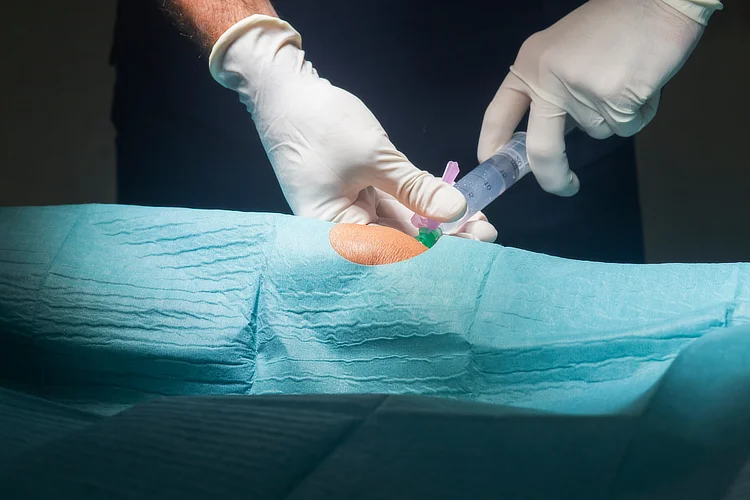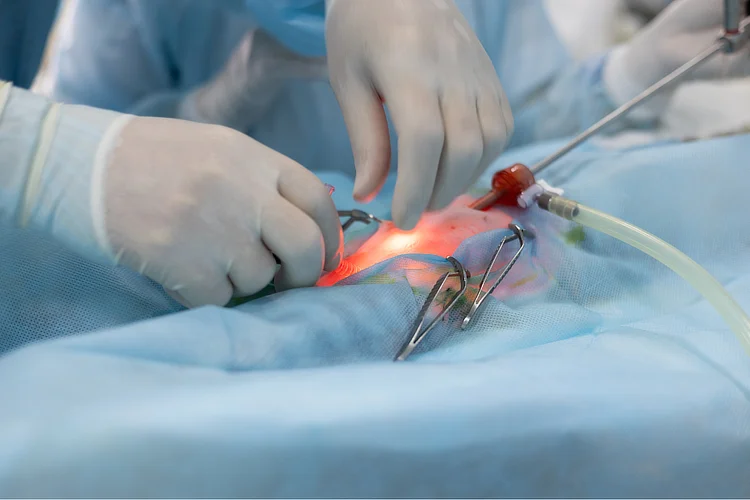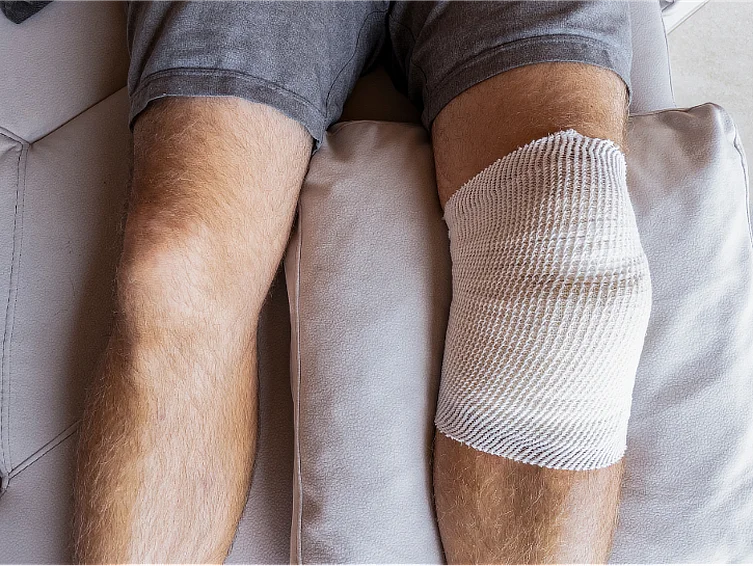Meniscus Tear Surgery: Procedure & Cost
Meniscus tear surgery is recommended when pain or limited function persists. Dr Foo uses minimally invasive arthroscopy to treat damaged cartilage, relieve symptoms, and support recovery.
MBBS (University of London) | MMed (Ortho) | FRCSEd (Ortho) | FAMS (Ortho)


What Is Meniscus Tear Surgery?

Meniscus tear surgery is performed to repair or remove damaged meniscus
tissue, a C-shaped cartilage located between the femur (thighbone) and tibia
(shinbone) in the knee.
The meniscus cushions the joint and stabilises movement but can
tear due to injury or wear and tear.
In cases of severe tears, surgery may be necessary to restore knee function, reduce
pain, and prevent further joint degeneration.
Who Might Benefit from Meniscus Tear Surgery?
Meniscus tear surgery may be recommended for those experiencing:
- Persistent knee pain that does not improve with non-surgical treatments such as physiotherapy and medication.
- Limited knee mobility, making daily activities difficult.
- A locked knee, where the joint becomes stuck in a certain position.
- Recurrent swelling and inflammation, despite rest and rehabilitation.
Types of Meniscus Surgery
Different types of meniscus surgery may be performed depending on the location of the tear, age, activity level, and overall knee health.
1. Meniscus Repair
A procedure in which the torn meniscus is reconstructed by suturing it back together to promote natural healing.
- Typically suitable for – Younger patients with tears in the outer region, where blood supply is sufficient. Meniscus repair is generally preferred over meniscectomy as it preserves the meniscus and reduces the risk of osteoarthritis.
- Type of tear treated – Bucket-handle tears (when repairable), flap tears, and horizontal tears in the vascular (outer) zone.
2. Partial / Total Meniscectomy
A partial meniscectomy removes the damaged portion of the meniscus while preserving healthy tissue. A total meniscectomy removes the entire meniscus, usually only when it is too damaged to be salvaged.
- Typically suitable for – Tears that cannot heal due to poor blood supply. Total meniscectomy is rarely performed as it increases the risk of joint instability and early osteoarthritis due to the loss of knee cushioning.
- Type of tear treated – Radial tears, flap tears, degenerative tears, bucket-handle tears, and flipped meniscus tears that cannot be repaired due to their location in the avascular (inner) zone.
3. Meniscus Transplant
A procedure in which a donor meniscus (allograft) is implanted to replace a previously removed or severely damaged meniscus.
- Typically suitable for – Young, active patients with post-meniscectomy pain and early cartilage damage, but without advanced arthritis or widespread joint degeneration.
- Type of tear treated – Post-meniscectomy syndrome, commonly seen in patients who previously underwent a total meniscectomy, leading to joint pain, instability, and cartilage deterioration.
How Is Meniscus Tear Surgery Performed?
Meniscus tear surgery is generally performed using arthroscopy,
a minimally invasive technique that uses small incisions and a tiny camera
(arthroscope) to visualise and treat the meniscus.
This approach reduces tissue damage, speeds up recovery, lowers the risk of complications, and
minimises scarring compared to open surgery.

The procedure involves the following steps:
- Arthroscope Insertion – A small incision is made to insert the arthroscope and instruments, allowing for assessment and repair of the tear.
- Surgical Treatment – Depending on the injury, surgery may involve suturing the torn edges (meniscus repair), removing damaged tissue (partial / total meniscectomy), or replacing it with a donor graft (meniscus transplant).
- Closure – The arthroscope and surgical instruments are removed, and the incisions are closed.
How Long Does Meniscus Surgery Take?
Meniscus surgery typically lasts between 30 minutes to an hour, depending
on the
complexity of the tear and the type of procedure. The procedure is
typically
considered a day surgery, meaning you can return home on the same day.
However, factors such as the
need for additional knee treatments, such as ligament repair
(ACL or PCL
reconstruction) or osteotomy for realignment, may extend the surgical time and recovery
period.
Side Effects After Meniscus Surgery
As with any surgical procedure, meniscus tear surgery carries some risks. Common side effects and potential complications may include:
- Swelling and stiffness in the knee
- Pain or discomfort, which usually improves with medication and physiotherapy
- Temporary knee weakness due to reduced activity
- Risk of infection, blood clots, or nerve injury (though rare)
- Re-tearing of the meniscus, particularly after repair
- Persistent knee instability due to the removal of part or all of the meniscus (meniscectomy)
- Graft failure (meniscus transplant), where the donor meniscus may not integrate properly, requiring revision surgery
It is important to follow post-operative care instructions to minimise complications and support recovery.
Knee Meniscus Surgery Recovery Time

Recovery time after meniscus surgery depends on the specific procedure performed.
- Meniscus Repair – Typically requires 3 to 6 months. Recovery involves initial knee immobilisation, followed by a structured rehabilitation programme to restore strength and function.
- Partial Meniscectomy – Recovery is generally quicker, around 4 to 6 weeks, since the torn portion of the meniscus is removed rather than repaired.
- Total Meniscectomy – Recovery time varies and depends on a prescribed rehabilitation plan to maintain knee function and reduce the risk of long-term joint instability.
Meniscus Tear Surgery Cost in Singapore
The cost of meniscus tear surgery varies, with estimated costs as follows:
| Procedure | Estimated Cost (SGD) |
|---|---|
| Meniscus Repair | $20,000 - $25,000 |
| Partial / Total Meniscectomy | $10,000 – $15,000 |
| Meniscus Transplant | $30,000 – $40,000 |
The cost typically includes the procedure and standard post-operative care, but additional
expenses may arise from pre-surgical assessments, follow-ups, and rehabilitation.
In Singapore, meniscus surgery is MediSave-claimable, with the claimable
amount depending on the procedure's complexity. Integrated Shield Plans may offer additional
coverage.
Contact us to explore your
financial options and coverage based on your needs.
Every patient deserves a treatment plan tailored to their needs. We start with non-surgical approaches before considering more invasive interventions.
Where Can I Find an Orthopaedic Surgeon for Meniscus Injury in Singapore?
Apex Novena
admin@apexsportsclinic.sg
101 Irrawaddy Rd, #18-12 Royal Square Medical Centre, Singapore 329565
Nearest MRT: NS20 Novena
Apex East Coast
admin@apexsportsclinic.sg
112 E Coast Rd, #03-03/04 i12 Katong, Singapore 428802
Nearest MRT: TE26 Marine Parade
Why Do Patients Choose Apex Sports Clinic?
Sports Doctor in Singapore: Personalised & Affordable Care
Progressive Treatment Philosophy
We prioritise personalised, non-invasive solutions, progressing to specialised treatments, including surgery, only when needed for more effective and targeted care.
Holistic Patient-Centred Care
From diagnosis to rehabilitation, we provide comprehensive and seamless care for a wide range of orthopaedic conditions.
Specialist in Sports Orthopaedics & Injury Management
We combine expert injury management with a proactive approach to maintaining your body’s strength and function, so you can recover fully and perform at your peak.
Patient Journey
1 . Schedule Your Appointment

2 . Expert Diagnosis & Consultation

3 . Customised Treatment Plan

Schedule an Appointment

Our Insurance Partners






Frequently Asked Questions (FAQs)
The recovery time depends on the type of meniscus surgery performed. Meniscus repair typically requires 3 to 6 months as the meniscus needs time to heal, with an initial period of limited weight-bearing and physiotherapy. Partial meniscectomy has a shorter recovery period of around 4 to 6 weeks since the damaged portion is removed rather than repaired. Meniscus transplant recovery can take up to 9 months, as the new meniscus must integrate with the surrounding tissue.
Meniscus surgery is considered a minimally invasive procedure rather than a major surgery. It is typically performed arthroscopically using small incisions, which reduces recovery time and the risk of complications. However, in cases requiring meniscus transplantation or combined procedures such as ACL reconstruction, the surgery may be more complex and require a longer recovery period.
Walking on a torn meniscus may worsen symptoms, particularly if the tear causes mechanical issues such as locking or instability. Small tears may not cause immediate problems, but repetitive stress on the knee can lead to further damage over time. It is advisable to avoid activities that cause pain and to seek medical advice for proper management.
Whether meniscus surgery is worthwhile depends on the severity of the tear, symptoms, and individual activity levels. Surgery is often recommended for patients with persistent pain, mechanical symptoms such as locking or catching, or tears in areas with poor healing potential. However, small or degenerative tears in older individuals may be managed conservatively with physiotherapy and lifestyle modifications. It is best to consult your doctor or specialist who can determine the most appropriate treatment for your condition.
Meniscus surgery is not painful during the procedure because anaesthesia is used. After surgery, pain levels vary. Partial meniscectomy usually causes mild discomfort while meniscus repair and transplant may result in more pain due to healing. Pain can be effectively managed with medication, icing and physiotherapy and it typically improves over time.
The meniscus does not naturally grow back once removed. However, meniscus repair allows the existing tissue to heal if the tear is in an area with good blood supply. If a large portion of the meniscus has been removed, a meniscus transplant may be an option to restore cushioning in the knee.
Meniscus repair and meniscectomy typically range from $9,000 to $25,000, while meniscus transplantation can cost up to $30,000. Prices may also depend on factors such as surgeon expertise, facility fees, and post-operative care.
Stair climbing is usually limited in the early recovery phase, especially after meniscus repair or transplant. Patients who undergo a partial meniscectomy may be able to climb stairs cautiously within a few days to weeks. Physiotherapy is essential for rebuilding knee strength and stability before resuming such activities. It is advisable to consult your surgeon or physiotherapist before attempting stairs.
If a meniscus tear is left untreated, it may lead to ongoing knee pain, swelling, and mechanical symptoms. Over time, an unstable meniscus can contribute to cartilage wear, increasing the risk of osteoarthritis. However, some small or degenerative tears may be managed conservatively if they do not cause significant symptoms. It is best to consult a doctor or specialist for proper assessment and treatment of your condition.
There is no fixed age limit for meniscus surgery, as suitability depends on factors such as knee health, activity level, and the presence of arthritis. Younger, active patients often benefit from meniscus repair, while older individuals with degenerative tears may be better managed with conservative treatments or knee replacement if arthritis is advanced. A specialist will assess your condition and recommend the most appropriate treatment.
A knee brace may be recommended for certain meniscus tears, particularly if there is instability or pain with movement. However, not all cases require bracing, and prolonged use without physiotherapy can lead to muscle weakening. A doctor or physiotherapist can best advise on whether a brace is necessary based on the severity of the tear.
The fastest recovery depends on following appropriate treatment, whether surgical or non-surgical. Rest, physiotherapy, strengthening exercises, and avoiding activities that strain the knee are essential. For those undergoing surgery, adhering to post-operative rehabilitation guidelines can help to speed up healing.
Limited knee bending is common in the early stages of recovery, especially after meniscus repair or transplant. Swelling, pain, and stiffness can temporarily restrict movement. Physiotherapy plays a crucial role in restoring range of motion. If stiffness persists despite rehabilitation, consult your doctor or specialist for further evaluation.
The decision to undergo meniscus surgery depends on factors such as the severity of symptoms, the type of tear, and activity levels. If conservative treatments like physiotherapy do not provide relief or if there are mechanical symptoms such as knee locking, surgery may be recommended. Consulting a doctor or specialist is the best way to determine if surgery is the right option for you.
The cost of arthroscopic meniscus surgery depends on the procedure. Meniscus repair typically ranges from $9,000 to $13,000, partial or total meniscectomy costs between $16,000 and $25,000, while meniscus transplantation ranges from $20,000 to $30,000. Prices may vary based on surgeon expertise, facility fees, and post-operative care.
Meniscus surgery is generally recommended if the tear causes pain, instability, or mechanical symptoms that affect daily activities. However, in cases of minor tears with minimal symptoms, non-surgical management may be a viable option. Consulting with a doctor or specialist can help determine the most appropriate treatment options.
Meniscus surgery is usually not an emergency unless there is a locked knee or severe instability. However, delaying treatment for symptomatic tears may lead to worsening damage over time. If you experience severe or persistent knee problems, it is best to consult a doctor or specialist for prompt diagnosis and treatment.
The decision to undergo surgery should be made in consultation with an orthopaedic specialist who will assess your condition and recommend the most suitable treatment. Factors to consider include the severity of symptoms, impact on daily activities, and the likelihood of successful non-surgical treatment.
A diet rich in anti-inflammatory foods such as omega-3 fatty acids, leafy greens, nuts, and collagen-rich sources like bone broth may support joint health. Maintaining a balanced diet helps with overall knee recovery.
Small, stable tears, particularly those in the outer vascular zone, may heal without surgery through physiotherapy and activity modifications. However, larger or unstable tears often require surgical intervention. It is best to consult a doctor or orthopaedic specialist for a proper evaluation to determine the most appropriate course of treatment.
Patients undergoing ACL reconstruction with meniscus surgery typically use crutches for 2 to 6 weeks, depending on the extent of the repair. Weight-bearing is gradually increased as healing progresses. It is important to follow your specialist’s or physiotherapist’s advice for optimal recovery.
Swelling is common after surgery and usually subsides with rest, ice therapy, and elevation. However, persistent or worsening swelling may indicate an issue such as infection or fluid buildup and should be promptly evaluated by your doctor or specialist.
Walking is usually possible within a few days to a week after a partial meniscectomy, while meniscus repair or transplant patients may need several weeks of limited weight-bearing before walking without crutches. It is best to follow your specialist’s or physiotherapist’s guidance for a smooth recovery.
To reduce the risk of arthritis, it is important to follow a structured rehabilitation programme, maintain a healthy weight, strengthen the surrounding muscles, and avoid excessive strain on the knee.
A knee brace may be advised for stability, particularly after meniscus repair, but not all patients require one. Prolonged use without proper rehabilitation could weaken muscles. It is best to consult your specialist or physiotherapist to determine whether a knee brace is necessary for your recovery.
Keyhole surgery refers to minimally invasive techniques used to treat meniscus tears. Arthroscopic surgery, a common form of keyhole surgery, involves inserting a small camera (arthroscope) and surgical instruments through tiny incisions to assess and repair the meniscus. This technique reduces tissue disruption, promotes faster recovery, and lowers the risk of complications compared to open surgery.

